|
| |
Archives
griffith baily coale
I'm still buried with work but I wanted to note a couple of good things that have happened. I've done a website on my Grandfather, Griffith Baily Coale. He was a mural painter in New York City in the 1930s and started the Naval Combat Artist program during WWII. He published a couple of books and I have them up on the web site with some additional writings. There is a lot more to add to the site but I've been distracted from it for almost three years now. I hope to get back to it soon. But, because the site is there, people have found me.
Several months ago I received an email from a storage facility in Connecticut. They had a painting done by Griff and wanted to know if I would be interested.
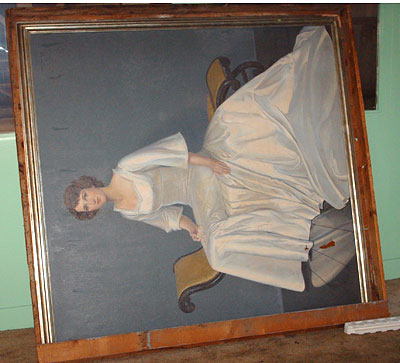
They ended up with it when a moving company next door went out of business. They had tried to find the family of the people who had originally wanted to move it but failed to locate anyone. Then they searched but the painter and found Griff's site and me. It's a large portrait: 68"x65". We don't know who the subject is but it was an opportunity to get another Griff painting for a *very* reasonable amount. It has a little damage but that is repairable. I asked around the family and my daughter Katie is going to take it. She will be sending in the final amount next week and then we will be getting it shipped back to the Coale family.
Monday I received an email from Louie, a member of the league of Women Voters in Eugene, Oregon. She was in charge of book sales for the League. They had been given a copy of Griff's North Atlantic Patrol, from a member, June, who had died, for their annual book sale. When Louie had gone to the web to find out about the book she found my site on Griff and thought I should be the one to have the book. This copy is quite unique. The owner of the book had been a nurse during WWII and there were 56 signatures, with home towns and some addresses, in the book. Louie didn't know the story behind it but it seemed these signatures were from the time June was a nurse in the war.
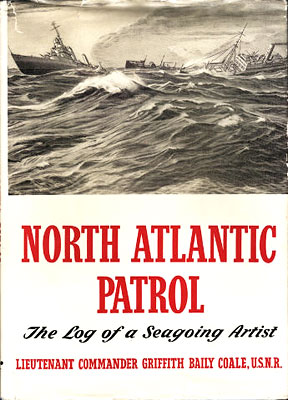
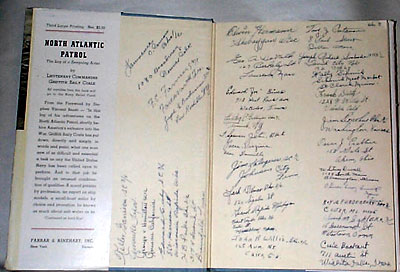
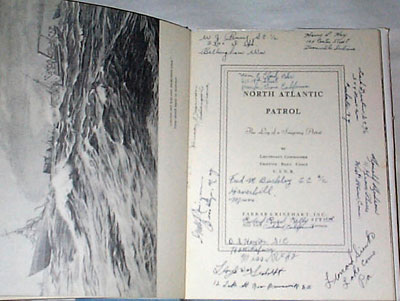
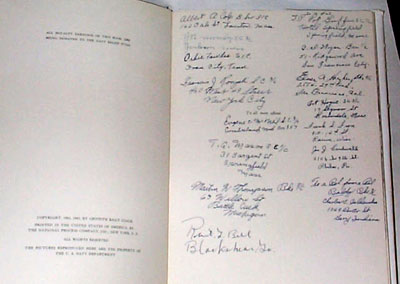
I'm honored to be the caretaker for this book. Louie wrote me: "I feel that we don't own books. We only have them in our libraries for a short while and then they are passed on to future generations. Those members of your Grandpop's generation are fast leaving us and we need to preserve their legacy. Your Grandfather did that with his art and you are doing it with your web site." I did find June's obituary on the web and hope to contact one of her children to see if they might know the story behind the signatures. The book arrive yesterday. I need to note this in Griff's site and get back to work on it but I need to finish off another site about Griff first: Gordy and Madelane's Great Pilgrimage. Soon.
busy
I've got a couple of large website projects to work on so things might be quite here for the next week or so.
oil
Is Energo-fascism in Your Future?
The Global Energy Race and Its Consequences (Part 1)
By Michael T. Klare
|
It has once again become fashionable for the dwindling supporters of President Bush's futile war in Iraq to stress the danger of "Islamo-fascism" and the supposed drive by followers of Osama bin Laden to establish a monolithic, Taliban-like regime -- a "Caliphate" -- stretching from Gibraltar to Indonesia. The President himself has employed this term on occasion over the years, using it to describe efforts by Muslim extremists to create "a totalitarian empire that denies all political and religious freedom." While there may indeed be hundreds, even thousands, of disturbed and suicidal individuals who share this delusional vision, the world actually faces a far more substantial and universal threat, which might be dubbed: Energo-fascism, or the militarization of the global struggle over ever-diminishing supplies of energy.
Unlike Islamo-fascism, Energo-fascism will, in time, affect nearly every person on the planet. Either we will be compelled to participate in or finance foreign wars to secure vital supplies of energy, such as the current conflict in Iraq; or we will be at the mercy of those who control the energy spigot, like the customers of the Russian energy juggernaut Gazprom in Ukraine, Belarus, and Georgia; or sooner or later we may find ourselves under constant state surveillance, lest we consume more than our allotted share of fuel or engage in illicit energy transactions. This is not simply some future dystopian nightmare, but a potentially all-encompassing reality whose basic features, largely unnoticed, are developing today.
| |
[more]
Petro-Power and the Nuclear Renaissance
Two Faces of an Emerging Energo-fascism (Part 2)
By Michael T. Klare
|
Not "Islamo-fascism" but "Energo-fascism" -- the heavily militarized global struggle over diminishing supplies of energy -- will dominate world affairs (and darken the lives of ordinary citizens) in the decades to come. This is so because top government officials globally are increasingly unwilling to rely on market forces to satisfy national energy needs and are instead assuming direct responsibility for the procurement, delivery, and allocation of energy supplies. The leaders of the major powers are ever more prepared to use force when deemed necessary to overcome any resistance to their energy priorities. In the case of the United States, this has required the conversion of our armed forces into a global oil-protection service; two other significant expressions of emerging Energo-fascism are: the arrival of Russia as an "energy superpower" and the repressive implications of plans to rely on nuclear power.
| |
[more]
I have By Michael T. Klare's book Blood and Oil: The Dangers and Consequences of America's Growing Dependence on Imported Petroleum waiting for me to pick up at my library.
photography
Watch this movie.
Stephen Shore
|
Stephen Shore is an influential American photographer. Selling his first photographs to the curator of the MOMA at age 14, and photographing Andy Warhol's factory at age 17, he has had a long and distinguished career, pioneering the art of color photography.
| |
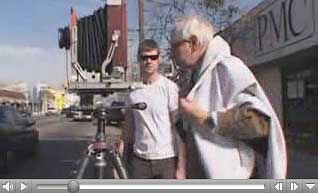
[more]
thanks to Conscientious
iraq
Retired Generals Criticize Bush’s Plan for Iraq
|
A panel of retired generals told a United States Senate committee today that sending 21,500 additional troops to Iraq will do little to solve the underlying political problems in the country.
“Too little and too late,” is the way Gen. Joseph P. Hoar, a former chief of the Central Command, described the effort to the Senate Foreign Relations Committee. The additional troops are intended to help pacify Baghdad and a restive province, but General Hoar said American leaders had failed to understand the political forces at work in the country. “The solution is political, not military,” he said.
“A fool’s errand,” was the judgment of Gen. Barry R. McCaffrey, who commanded troops in the first Gulf War. He said other countries had concluded that the effort in Iraq was not succeeding, noting that “our allies are leaving us and will be gone by summer.”
| |
[more]
Moqtada's interview at La Repubblica, translated
|
He feels stalked and goes into hiding. He sleeps no more than one night in the same bed. Some of his most faithful allies have already turned their backs. He has even moved his family to an undisclosed location. Muqtada al-Sadr feels that the end is near. Enemy forces, forces infiltrated amongst his own people! Yet for him it is not about al-Málikí, whom he considers little more than a puppet, so much as about ’Iyád al-‘Alláwí, the former prime minister, whom the Americans have never stopped aiming [to empower]. He [‘A.] is the true director of the operation which proposes to wipe him [S.] off the face of Iraq, him and his Mahdi Army.
| |
[more]
War costs are hitting historic proportions
The price tag for the Iraq conflict and overall effort against terrorism is expected to surpass Vietnam's next year.
|
By the time the Vietnam war ended in 1975, it had become America's longest war, shadowed the legacies of four presidents, killed 58,000 Americans along with many thousands more Vietnamese, and cost the U.S. more than $660 billion in today's dollars.
By the time the bill for World War II passed the $600-billion mark, in mid-1943, the United States had driven German forces out of North Africa, devastated the Japanese fleet in the Battle of Midway, and launched the vast offensives that would liberate Europe and the South Pacific.
The Iraq war is far smaller and narrower than those conflicts, and it has not extended beyond the tenure of a single president. But its price tag is beginning to reach historic proportions, and the budgetary "burn rate" for Iraq may be greater than in some periods in past wars.
| |
[more]
thanks to Bad Attitudes
The GOP in a Quagmire
|
The sense of impending political doom that clutches Republican hearts one week after President Bush presented his new strategy on Iraq to the nation is stoked by the alarming intelligence brought back from Baghdad by Republican Sen. Norm Coleman of Minnesota and passed around Capitol Hill.
| |
[more]
Iraq: Beyond the Gallows
|
Many observers have assumed that Saddam Hussein’s execution was yet another Iraqi “milestone” timed to serve the needs of a struggling American president. Milestone it was, but indications now suggest that this was, on the contrary, a marker that Washington was desperate to forestall. And for good reason: in pressing for Saddam’s execution, Iran appears to have reached over America’s head and graphically demonstrated that it is now the preeminent political force inside Iraq.
| |
[more]
digital images
I've probably linked to this before but it's worth linking to again. And again. 520,000 images. That should keep you amused for a couple of evenings.
NYPL Digital Gallery
|
NYPL Digital Gallery provides access to over 520,000 images digitized from primary sources and printed rarities in the collections of The New York Public Library, including illuminated manuscripts, historical maps, vintage posters, rare prints and photographs, illustrated books, printed ephemera, and more.
| |
[more]
thanks to daily KOS
Here are a couple of sections.
Ellis Island Photographs from the Collection of William Williams, Commissioner of Immigration, 1902-1913

[more]
Lewis Wickes Hine: Documentary Photographs, 1905-1938
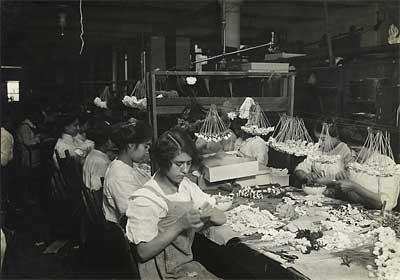
[more]
iran
So, do you think there will be war?
|
“So, do you think there will be war?” This is the way Keivan starts every conversation these days.
There is a reason: for the third time since we came to Iran, people are seriously afraid of being attacked.
“Please, when you go back to America,” a spice salesman tells me, “tell them not to attack us.” He was probably doubly afraid because his shop is about a mile from a heavily guarded military-industrial site.
| |
[more]
US military strike on Iran seen by April ’07
Sea-launched attack to hit oil, N-sites
|
KUWAIT CITY: Washington will launch a military strike on Iran before April 2007, say sources. The attack will be launched from the sea and Patriot missiles will guard all oil-producing countries in the region, they add. Recent statements emanating from the United States indicate the Bush administration’s new strategy for Iraq doesn’t include any proposal to make a compromise or negotiate with Syria or Iran. A reliable source said President Bush recently held a meeting with Vice President Dick Cheney, Defense Secretary Robert Gates, Secretary of State Dr Condoleezza Rice and other assistants in the White House where they discussed the plan to attack Iran in minute detail.
| |
[more]
The Pieces Are Being Put in Place
Escalation Against Iran
|
The pieces are moving. They’ll be in place by the end of February. The United States will be able to escalate military operations against Iran.
| |
[more]
Chris Nelson Provides Reality Check on Iran's Nuke Capacity
|
IRAN. . .recent news stories out of the Middle East seem to be generating a sense that Iran is closer to a successful nuclear weapons capability than had previously been thought, and that the risk to Israel is rising to the point where Israel is moving closer to a decision to "take out" the Iranian nuclear weapons facilities.
Balderdash, our informed sources continue to maintain.
Yes, it does seem to be true that Iran has accelerated its program to bring on line the 3,000 centrifuges required to generate nuclear fuel. . .but it also seems true (and not Iranian disinformation) that of the 50 centrifuges recently hooked up, all 50 blew up.
| |
[more]
Cheney blew off Iran in 2003
For the Love of God Impeach this Man
|
Lawrence Wilkerson, an aide to Colin Powell when he was secretary of state says that Iran in 2003 offered to help stabilize Iraq and to cut off aid to Hizbullah in Lebanon and to Hamas. Wilkerson says that the State Department was interested in pursuing the offer, which presumably came from reformist president Mohammad Khatami. He says that when the issue was broached with VP Richard Bruce Cheney, Cheney shot down any notion of "talking to evil." As if Mohammad Khatami is evil and Richard Bruce Cheney is not. (Cheney's lies about Iraq's weapons of mass destruction and connection to 9/11 have gotten hundreds of thousands of people killed).
| |
[more]
photography
wood s lot linked to these photochoms at the Library of Congress. I didn't know about this early color photography process but the Library of Congress has 5,000 high quality scans.
Photochrom
|
Photochrom or Photochrome is a colorizing process combining photography and color lithography. Photochrome may also refer to the modern age of color postcards in America.
Photochrom is used to createea color print from a black and white photo negative, using between four and fourteen lithograph stones, made from rocklike substances, to colorize the print with several different inks.
The photochrom process was most popular in the 1890s, when color photography was first being developed but commercially impractical. Photochrom was developed in Zürich, hence its proper name being spelled without the final 'e,' and was brought to popularity by the Detroit Photographic company. When the US Congress authorized the one-penny postcard, thousands of photochrom prints, usually of cities or landscapes, were created and sold as postcards. Photochrom typifies the look and feel of "postcard pictures."
| |
[more]
And here are those 5,000 photochroms with high quality digital files suitable for printing.
Photochrom Prints
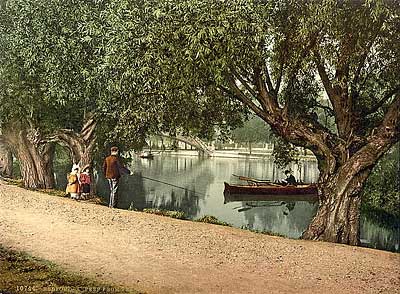
[more]
American Photochrom
The Photochrom Mystery
israel/palestine
Silent About Gaza
|
A genocide is engulfing the people of Gaza while a silence engulfs its bystanders. "Some 1.4 million people, mostly children, are piled up in one of the most densely populated regions of the world, with no freedom of movement, no place to run, and no space to hide," wrote the senior UN relief official, Jan Egeland, and Jan Eliasson, then Swedish foreign minister, in Le Figaro. They described people "living in a cage," cut off by land, sea, and air, with no reliable power and little water, tortured by hunger, disease, and incessant attacks by Israeli troops and planes.
Egeland and Eliasson wrote this four months ago as an attempt to break the silence in Europe, whose obedient alliance with the United States and Israel has sought to reverse the democratic result that brought Hamas to power in last year's Palestinian elections. The horror in Gaza has since been compounded; a family of 18 has died beneath a 500-pound American/Israeli bomb; unarmed women have been mown down at point-blank range. Dr. David Halpin, one of the few Britons to break what he calls "this medieval siege," reported the killing of 57 children by artillery, rockets, and small arms and was shown evidence that civilians are Israel's true targets, as in Lebanon last summer. A friend in Gaza, Dr. Mona El-Farra, e-mailed: "I see the effects of the relentless sonic booms [a collective punishment by the Israeli air force] and artillery on my 13-year-old daughter. At night, she shivers with fear. Then both of us end up crouching on the floor. I try to make her feel safe, but when the bombs sound I flinch and scream…"
When I was last in Gaza, Dr. Khalid Dahlan, a psychiatrist, showed me the results of a remarkable survey. "The statistic I personally find unbearable," he said, "is that 99.4 percent of the children we studied suffer trauma. Once you look at the rates of exposure to trauma you see why: 99.2 percent of their homes were bombarded; 97.5 percent were exposed to tear gas; 96.6 percent witnessed shootings; 95.8 percent witnessed bombardment and funerals; almost a quarter saw family members injured or killed." Dr. Dahlan invited me to sit in on one of his clinics. There were 30 children, all of them traumatized. He gave each pencil and paper and asked them to draw. They drew pictures of grotesque acts of terror and of women streaming tears.
| |
[more]
How Israel Enforces "Demographic Separation"
Carter Doesn't Tell the Half of It
|
Lieberman has been widely presented as a political maverick, akin to the notorious racist Rabbi Meir Kahane, whose Kach party was outlawed in the late 1980s. That is a gross misunderstanding: Lieberman is at the very heart of the country’s rightwing establishment and will almost certainly be a candidate for prime minister in future elections, as Israelis drift ever further to the right.
Unlike Kahane, Lieberman has cleverly remained within the Israeli political mainstream while pushing its agenda to the very limits of what it is currently possible to say. Kadima and Labor urgently want unilateral separation from the Palestinians but are shy to spell out, both to their own domestic constituency and the international community, what separation will entail.
Lieberman has no such qualms. He is unequivocal: if Israel is separating from the Palestinians in parts of the occupied territories, why not also separate from the 1.2 million Palestinians who through oversight rather than design ended up as citizens of a Jewish state in 1948? If Israel is to be a Jewish fortress, then, as he points out, it is illogical to leave Palestinians within the fortifications.
These arguments express the common mood among the Israeli public, one that has been cultivated since the eruption of the intifada in 2000 by endless talk among Israel’s political and military elites about “demographic separation”. Regular opinion polls show that about two-thirds of Israelis support transfer, either voluntary or forced, of Palestinian citizens from the state.
Recent polls also reveal how fashionable racism has become in Israel. A survey conducted last year showed that 68 per cent of Israeli Jews do not want to live next to a Palestinian citizen (and rarely have to, as segregation is largely enforced by the authorities), and 46 per cent would not want an Arab to visit their home.
| |
[more]
photography
Running from Camera
|
The rules are simple: I put the self-timer on 2 seconds, push the button and try to get as far from the camera as I can.
| |
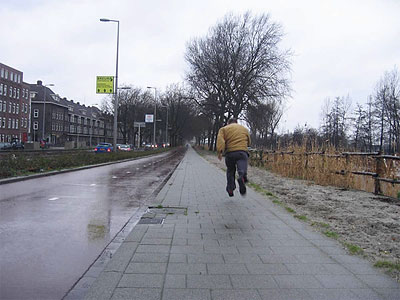
[more]
thanks to J-Walk Blog
impeach the bastard
Bush Must Go
Only Impeachment Can Stop Him
|
When are the American people and their representatives in Congress and the military going to wake up and realize that the US has an insane war criminal in the White House who is destroying all chances for peace in the world and establishing a police state in the US?
Americans don’t have much time to realize this and to act before it is too late. Bush’s “surge” speech last Wednesday night makes it completely clear that his real purpose is to start wars with Iran and Syria before failure in Iraq brings an end to the neoconservative/Israeli plan to establish hegemony over the Middle East.
| |
[more]
Not Only the Worst President, but the Worst Possible President
|
Little George isn't the same guy he was in 2000, the guy described by Gail Sheehy in her Vanity Fair profile--hyper-competitive and dyslexic, prone to cheat at games, always swinging between screwing up and making up, hating criticism and disagreement, careless of others but often charming. He is no longer the guy who the Republicans thought they could control (unlike, say, McCain). The small pathologies of Bush the candidate have, thanks to the purposes of the neocons and the religious right, been enhanced and upgraded. We have a bona fide madman now, who thinks of himself in a grandiose way as single-handedly turning the tide of history. Some of his Frankensteins have bailed, some haven't dared to, and others still seem to believe. His actions and his orders, especially about Iran, seem to be telling us that he will stop at nothing to prove his dominance. The elder Bush(es), Scrowcroft, Baker, and their friends, Cheney, Rumsfeld, Gerson, and the neocons have made the monster and in the process endangered the country, the Constitution, and the world, not to mention the sanity of wretches like Jose Padilla (for an analysis of the real reason Gitmo continues to exist, see Dahlia Lithwick's article in Slate, here. Maybe the bums planned this mess for their own profit, or maybe they planned to profit without mess; maybe some of them regret what they have wrought. However, they all share the blame for whatever he does next.
| |
[more]
transportation
When I was a boy living in japan in the late 1950s, I was taken by the fleets of little three wheel trucks. I've always wanted something like that. Now electric three wheel trucks are being imported from China.
Zap!

[more]
Unfortunately it only does about 35mph with a range of 40 miles and costs $12,000. I reminds me of the first Subaru imported into the US in late 1960s. It was powered by a 360cc 25 hp two-stroke motor. I remember a magazine report that claimed you could take the amount of money a Subaru 360 cost and buy a used car, *any* used car, and be better off. One winter day in the early 1970s I was hitchiking north on Highway 99 in north Seattle during a snow storm (I think my car had broken down) and was picked up in one of these little Subarus. The magazine was right. Scary.
economy
Here is an interesting map showing the relative strengths of world economies.
Norge seen from USA.
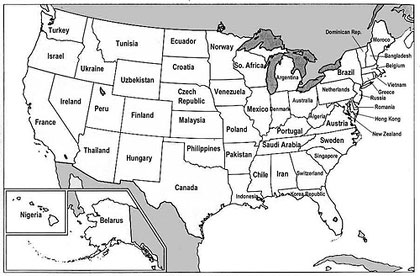
[more]
thanks to J-Walk Blog
books
Here is a wonderful source of scanned pictures from old books.
Scanned Images, Engravings and Pictures From Old Books
|
Remains of Ruined Castles, Deserted Abbeys, Old Manor Houses, mansions and stately homes; also engravings, woodcuts and pictures of Old England and Wales; also other subjects mentioned below, including Pictures of old books, scanned, prepared and published by Liam Quin.
| |
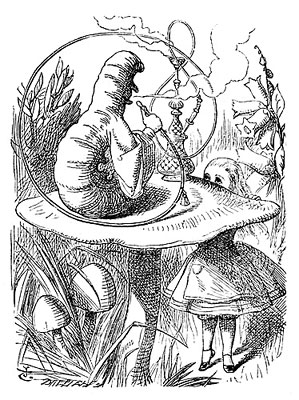
[more]
thanks to daily KOS
health care
For Profit Medicine
| ...the hospital revamped how it treated some expensive ailments, cutting down high-tech tests and high-end specialists.
But a troublesome pattern emerged: The more cost-effective it became, the bigger financial hit the medical center took. "Everyone gained but Virginia Mason," says its chief of medicine, Robert Mecklenburg.
With each MRI that Aetna and the employers avoided at around $850, Virginia Mason lost about $450 in profit. The payment system of government-sponsored Medicare, which private health plans also use as a template, tends to reward the big capital expenses of buying high-tech machines such as MRIs. The more the machines are used, the bigger profit margin they pack. Meanwhile, reimbursement fees for doctors' visits have stagnated.
"The payment system is so toxic," says Francois de Brantes, a former health-care program director at General Electric Co. "Unless you tackle it, any health-care reform doesn't have much chance." Mr. de Brantes coordinates a program funded by employers that pays doctors bonuses based on patients' outcomes.
Notice the perverse incentives? You could hardly miss them. When the goal of healthcare is to make profits - when doctors are individual contractors, when hospitals are profit making centers, then they will act to maximize profits - not the health of their patients, and certainly they won't act to reduce how much they can bill people by.
| |
[more]
book recommendations
    
This is sort of a Ben Shahn festival. I don't hear much about Shahn now but he is someone whose work speaks to me and has for along time. I first ran across Ben Shahn in the early 1960s as a young Architecture student. I found The Shape of Content. This is the first book about art that I bought. I still have it and I reread it every few years. Ben Shahn: An Artist's Life is a biography, Common Man, Mythic Vision is about his paintings, and Ben Shahn's New York: The Photography of Modern Times is about his photography. I've had these books ready to post for some time but there was one that I had been looking for that I only found a couple of days ago: Ounce, Dice, Trice, which is out of print. I finally found some boxes of books that I hadn't noticed and it was in the last box that I found it! While his paintings and photographs are great, it's his drawings that I never tire of looking at. Since the book is out of print I've scanned it.
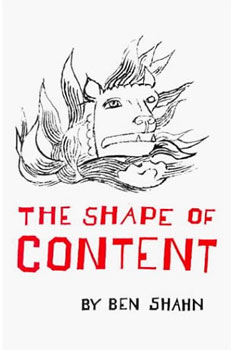
The Shape of Content
(The Charles Eliot Norton Lectures)
by Ben Shahn
This book came out in the early 1960s and is still in print. It still makes sense.
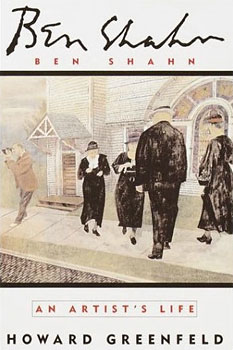
Ben Shahn: An Artist's Life
by Howard Greenfeld
From Amazon:
|
There was a time when nearly everyone recognized Ben Shahn's scathing pictures from his most famous series, The Passion of Sacco and Vanzetti, 1932. Sacco and Vanzetti, two working-class anarchists convicted on trumped-up murder charges, lie dead in their coffins. Behind them stand the top-hatted men of the old, Anglo establishment, hypocritically mourning the poor immigrants whose lives they destroyed.
These days, it may be hard to understand how vital such storytelling artists were to the political life of their times. In Ben Shahn: An Artist's Life, Howard Greenfeld does justice to those heady days, placing both Shahn and his work in the context of the Great Depression, the rise of unions and social relief programs, and the beginnings of the civil rights movement. With uncommon fairness, Greenfeld also chronicles the difficult, contradictory personal life of this brilliant artist, who, for example, began and ended his career working on Jewish themes but cruelly abandoned his first wife, Tillie, and their two children to marry a Christian woman.
Greenfeld adeptly traces Shahn's development as one of the 20th century's most important illustrators and narrative artists, comparable to Daumier and even to Goya.
| |

Common Man, Mythic Vision
by Susan Chevlowe
From amazon:
|
With Social Realism out of favor with many critics, the artistic reputation of American artist Ben Shahn (1898-1968) has been in decline since his death. The recent interest in Shahn's life and work evidenced in the exhibition of his later pieces at the Jewish Museum in New York City and the recent biography by Howard Greenfeld (Ben Shahn: An Artist's Life, LJ 10/1/98) is refreshing. The four essays included in this catalog cover his life, his work on various New Deal art project murals, the relationship of his work to postwar American art, and the allegorical content of his disarmingly realist work. The color plates illustrating works in the exhibition are beautifully reproduced and provide a good introduction to Shahn's work and an excellent visual accompaniment to the Greenfeld biography.
| |
Common Man, Mythic Vision: The Paintings of Ben Shahn
|
The Jewish Museum will present Common Man, Mythic Vision: The Paintings of Ben Shahn from November 8, 1998 to March 7, 1999. Commemorating the centennial year of this acclaimed American artist, the exhibition will feature 52 of the finest paintings created by Ben Shahn between 1936 and 1965. Tracing the development of the artist's career and focusing primarily on his mature style as it evolved following the trauma of World War II and its aftermath, Common Man, Mythic Vision is the first major museum exhibition in the U.S. since 1976, when The Jewish Museum presented a retrospective, Ben Shahn: 1898-1969. Works on view are being loaned from major museums and private collections in the United States, Japan, Sweden and The Vatican. A sampling of Shahn's photographs, advertisements, printed books, masks, and magazine articles is also included, along with a five-minute video of excerpts from two 1960s television interviews with the artist.
| |
[more]
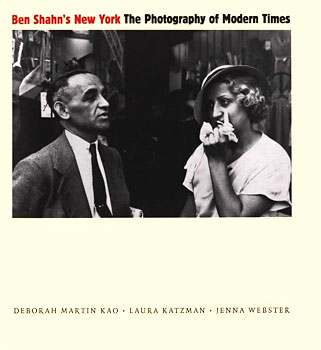
Ben Shahn's New York:
The Photography of Modern Times
by Deborah Martin Kao, Laura Katzman, Jenna Webster
It wasn't until a few years ago that I found out that Shahn was also a photographer. He was one of the original photographers with Roy Stryker and the Farm Security Administration. This book mentions his FSA work but is primarily focused on his work in New York prior to that. He was a friend of Walker Evans and share a studio with him. I didn't know about these pictures until I read this book. Some amazing stuff.
|
With a desire to promote social justice and a deep compassion for humanity, Shahn (1898-1969) was actively involved in social protests and leftist causes in New York City during the 1930s. Although better known for his paintings, murals, and satirical drawings, Shahn was also a talented photographer, influenced by filmmaking and documentary photography as well as his social concerns. Camera skills learned from close friend Walker Evans enabled Shahn to create candid images--of laborers, immigrants, children, the neighborhoods and storefronts of Manhattan, poverty, and unemployment--that became a potent sociopolitical statement during the Depression years. Over the next year the show will be traveling from the organizing institution, Harvard University Art Museums, to major venues in Washington, New York, and Chicago. The authors, who organized the exhibition, have written illuminating essays demonstrating meticulous scholarship. More than 200 duotones, many that Shahn integrated into his paintings, are brilliantly paired in this publication; an appendix with delightful memorabilia caps the work. A gem for both photography and fine arts collections.
| |
It was Ben Shahn and these pictures that was one of the inpirations for my Zorki Standard project. Ben used an early Leica Ia from 1927.
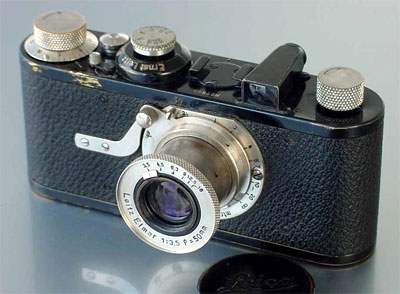
(There are a bunch for sale here if you would like to get me one.)
Not only that, but he used a right angle finder, that Leitz called a WINKO, which had him appear to be looking in another direction..
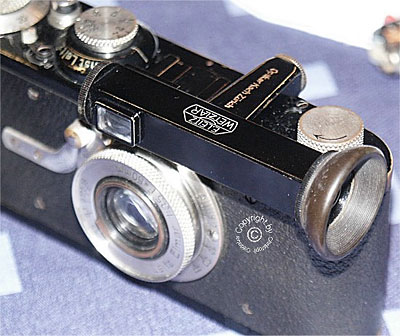
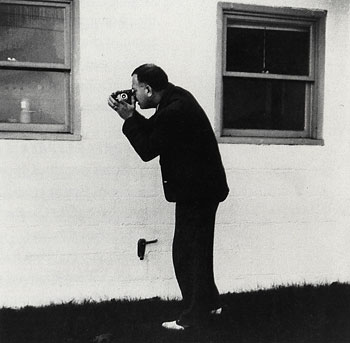
Using a camera like the Leica Ia is a different experience from using more modern equipment. Part of making the Zorki Standard was to feel what that experience was like. Now I need a WINKO!
Shahn's photographs often ended up in his paintings. He started using the camera as a sketch pad for his paintings but the photographs were also an end in themselves.
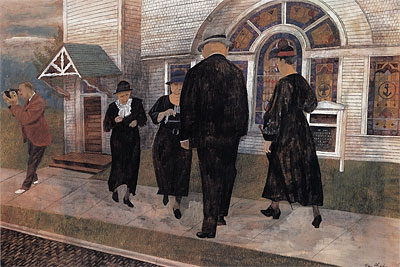
Leica I (A)
The Most Important 35 of All Time:
the Leica A of 1925-1936
Ben Shahn's New York: The Photography of Modern Times
|
Ben Shahn's New York: The Photography of Modern Times
Including over 150 photographs, ink drawings, easel paintings, mural studies, and relevant ephemera, this landmark exhibition focuses on Shahn's personal use of photography as a primary research tool for subsequent works in diverse media and offers a unique perspective for examining other aspects of Shahn's oeuvre. Ben Shahn 's New York will give visitors the opportunity to view an important and little-examined body of Shahn's work, which was formative for the artist's photographic aesthetic and his working process.
| |
[more]
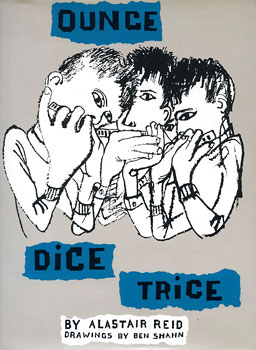
Ounce, Dice, Trice
by Alastair Reid
drawings by Ben Shahn
This a match made in heaven (if only I believed in heaven). The whimsical words of Alastair Ried and the drawings of Ben Shahn. I think it was Blaine that gave this book to me. (I could be wrong. Blaine will set me right.) A wonderful book. It's out of print but it's worth tracking down a used copy. Until then, I've scanned it and you can enjoy it now: Ounce, Dice, Trice.
C O T T O N P I C K E R S
Photographer: Ben Shahn
Pulaski County, Arkansas, October 1935
Resettlement Administration, Lot 1657
|
Ben Shahn made two important contributions to the newly formed Historical Section in 1935. First, of course, were the photographs he himself added to the agency's file. The portion dating from 1935 is small--less than 2 percent of the eight-year accumulation--but about one-third of those early images are Shahn's. And second, his counsel, along with that of several colleagues at the Resettlement Administration, helped Roy Stryker clarify his mission.1 Shahn's sophistication as a painter and printmaker and his keenly felt moral sensibility influenced the running dialogue he had with Stryker. Once, Shahn recalled in 1964, he had explained to Stryker that a certain photograph of soil erosion would not have a strong impact on viewers. "Look Roy," Shahn said, "you're not going to move anybody with this eroded soil--but the effect this eroded soil has on a kid who looks starved, this is going to move people."
| |
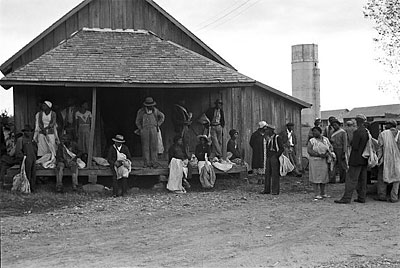
[more]
Ben Shahn
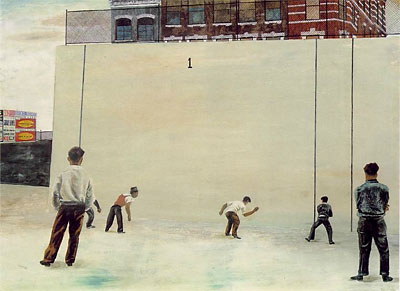
[more]
Ben Shahn
[Lithuanian-born American Social Realist Painter and Photographer, 1898-1969]
Ben Shahn at Harvard
|
|
|
|






























